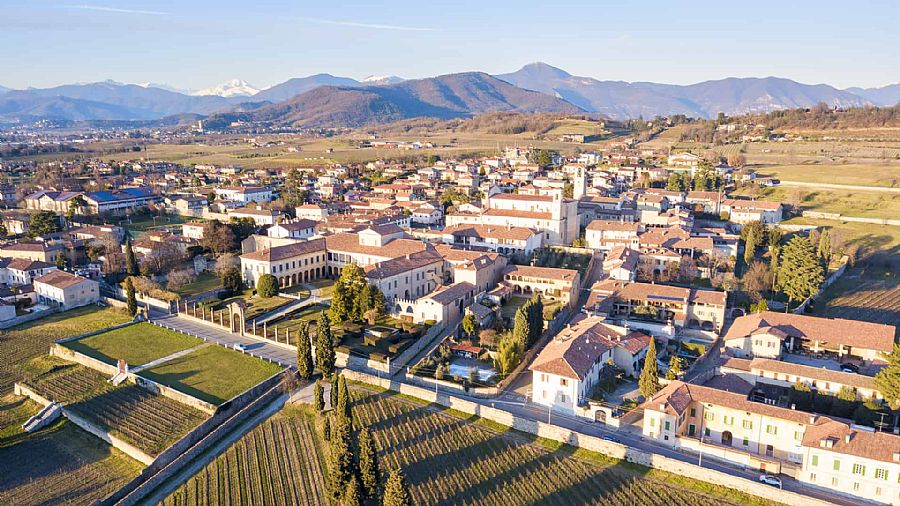Erbusco

Situated below Mt Orfano in the hills of the Franciacorta wine country, Erbusco is a short hop to Lake Iseo. In easy reach are the lakeside towns of Sarnico, Paratico, Clusane, and of course Iseo. The town itself is charming and level, making for easy walking, and sits in the middle of vast vineyards with green hills beyond, so it is quite picturesque.
It is in the province of Brescia (Lombardy region) and has a population of about 8700 people. With services, shops, restaurants, an excellent pastry shop, and wineries right in town, you can walk to a lot for daily life while you're here. Since it is wine country, a note should be made about Franciacorta; for those who don't know, it is a sparkling wine with DOCG designation and produced only in this small swath of the Brescia province. It is prized for its qualities derived from the volcanic soil and microclimate. With its golden hue and notes of apple, slightly vanilla, and area herbal tones, it is refreshing. Be sure to visit some of the wineries while you're here!
Erbusco's long-ago origins date to 5000 BC and the neolithic period. Then came the Cenomani (a Gallic tribe), Celts, Etruscans, Romans, Lombards, and Gallic peoples, so it has seen a lot of movement through its territory. The medieval castle was built in the 10th century and expanded later in the 12th or 13th century, while the noteworthy Pieve of Santa Maria was constructed in the 12th century. While the front and sides look rough and unfinished, the semi-circular apse is elegant and clad in white. Inside are some beautiful paintings and frescoes.
Erbusco was controlled by the French who occupied the entire Brescia area in the 1500s, then controlled by the Republic of Venice until 1797. At the end of the Venetian Republic the French under Napoleon entered, then the Lombard-Veneto regions were under the Austro-Hungarian empire until the unification and the Kingdom of Italy in 1861.
Of particular interest around town besides the beautiful Pieve and the medieval Castello but it has been incorporated into the medieval lanes and homes so is like a fortified neighborhood. The parish church of Santa Maria Assunta, a pretty neo-Renaissance church; the land was purchased and the church plans drawnin up in 1694 but the work was interrupted by war. The church wasn't finished until 1719. The frescoes were completed over a decade, and the church was finally officially consecrated by the bishop in 1856. That church is not to be confused with the Pieve of Santa Maria, an ancient and intriguing structure that appears rough and unfinished on the front and sides, yet the apse is clad in white. Inside are frescoes; in the apse they recount the Story of the Virgin and others, executed by an unknown artist known only as il Maestro. Isolated from the town is the former monastery of San Bernardino, now a cemetery but interesting nontheless.
Wander around town for hidden delights. In Via Verdi you'll find the once-opulent palazzi of the lords and nobles of the time - Palazzo Lechi with elegant garden, Palazzo Longhi that had been a hospital before being turned into a private palace, Palazzo Marchetti di Montestrutto in Via Martinengo, and the 19th century Liberty-style Palazzo Cavalleri, now the town hall, with richly decorated rooms and some impressive Venetian chandeliers.
Of course, wine country and the scenery of the vineyards covering the hills are a big draw, as are country walks and of course, wine tasting!
Browse carefully selected home rentals in Erbusco .

 Amalfi Coast
Amalfi Coast Sorrento Coast
Sorrento Coast Tuscany
Tuscany Cilento National Park
Cilento National Park Lake Como
Lake Como Rome and Latium
Rome and Latium Umbria
Umbria Capri and Ischia
Capri and Ischia Venice
Venice Puglia (Apulia)
Puglia (Apulia) Liguria
Liguria Sicily
Sicily Lake Maggiore
Lake Maggiore Lombardy
Lombardy Sardinia
Sardinia Lake Garda
Lake Garda Abruzzo and Marche
Abruzzo and Marche Calabria
Calabria